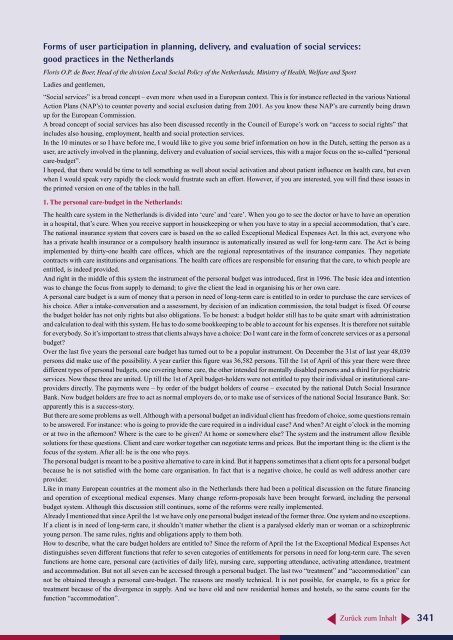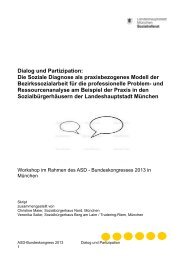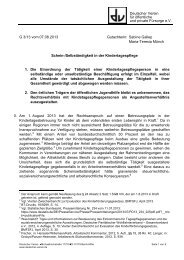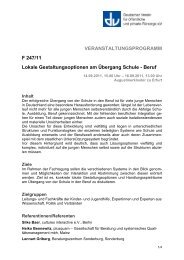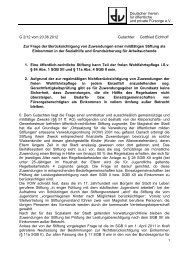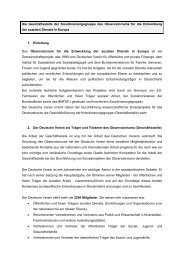Workshop 1.6 - Deutscher Verein für öffentliche und private Fürsorge
Workshop 1.6 - Deutscher Verein für öffentliche und private Fürsorge
Workshop 1.6 - Deutscher Verein für öffentliche und private Fürsorge
Sie wollen auch ein ePaper? Erhöhen Sie die Reichweite Ihrer Titel.
YUMPU macht aus Druck-PDFs automatisch weboptimierte ePaper, die Google liebt.
Forms of user participation in planning, delivery, and evaluation of social services:<br />
good practices in the Netherlands<br />
Floris O.P. de Boer, Head of the division Local Social Policy of the Netherlands, Ministry of Health, Welfare and Sport<br />
Ladies and gentlemen,<br />
“Social services” is a broad concept – even more when used in a European context. This is for instance reflected in the various National<br />
Action Plans (NAP’s) to counter poverty and social exclusion dating from 2001. As you know these NAP’s are currently being drawn<br />
up for the European Commission.<br />
A broad concept of social services has also been discussed recently in the Council of Europe’s work on “access to social rights” that<br />
includes also housing, employment, health and social protection services.<br />
In the 10 minutes or so I have before me, I would like to give you some brief information on how in the Dutch, setting the person as a<br />
user, are actively involved in the planning, delivery and evaluation of social services, this with a major focus on the so-called “personal<br />
care-budget”.<br />
I hoped, that there would be time to tell something as well about social activation and about patient influence on health care, but even<br />
when I would speak very rapidly the clock would frustrate such an effort. However, if you are interested, you will find these issues in<br />
the printed version on one of the tables in the hall.<br />
1. The personal care-budget in the Netherlands:<br />
The health care system in the Netherlands is divided into ‘cure’ and ‘care’. When you go to see the doctor or have to have an operation<br />
in a hospital, that’s cure. When you receive support in housekeeping or when you have to stay in a special accommodation, that’s care.<br />
The national insurance system that covers care is based on the so called Exceptional Medical Expenses Act. In this act, everyone who<br />
has a <strong>private</strong> health insurance or a compulsory health insurance is automatically insured as well for long-term care. The Act is being<br />
implemented by thirty-one health care offices, which are the regional representatives of the insurance companies. They negotiate<br />
contracts with care institutions and organisations. The health care offices are responsible for ensuring that the care, to which people are<br />
entitled, is indeed provided.<br />
And right in the middle of this system the instrument of the personal budget was introduced, first in 1996. The basic idea and intention<br />
was to change the focus from supply to demand; to give the client the lead in organising his or her own care.<br />
A personal care budget is a sum of money that a person in need of long-term care is entitled to in order to purchase the care services of<br />
his choice. After a intake-conversation and a assessment, by decision of an indication commission, the total budget is fixed. Of course<br />
the budget holder has not only rights but also obligations. To be honest: a budget holder still has to be quite smart with administration<br />
and calculation to deal with this system. He has to do some bookkeeping to be able to account for his expenses. It is therefore not suitable<br />
for everybody. So it’s important to stress that clients always have a choice: Do I want care in the form of concrete services or as a personal<br />
budget?<br />
Over the last five years the personal care budget has turned out to be a popular instrument. On December the 31st of last year 48,039<br />
persons did make use of the possibility. A year earlier this figure was 36,582 persons. Till the 1st of April of this year there were three<br />
different types of personal budgets, one covering home care, the other intended for mentally disabled persons and a third for psychiatric<br />
services. Now these three are united. Up till the 1st of April budget-holders were not entitled to pay their individual or institutional careproviders<br />
directly. The payments were – by order of the budget holders of course – executed by the national Dutch Social Insurance<br />
Bank. Now budget holders are free to act as normal employers do, or to make use of services of the national Social Insurance Bank. So:<br />
apparently this is a success-story.<br />
But there are some problems as well. Although with a personal budget an individual client has freedom of choice, some questions remain<br />
to be answered. For instance: who is going to provide the care required in a individual case? And when? At eight o’clock in the morning<br />
or at two in the afternoon? Where is the care to be given? At home or somewhere else? The system and the instrument allow flexible<br />
solutions for these questions. Client and care worker together can negotiate terms and prices. But the important thing is: the client is the<br />
focus of the system. After all: he is the one who pays.<br />
The personal budget is meant to be a positive alternative to care in kind. But it happens sometimes that a client opts for a personal budget<br />
because he is not satisfied with the home care organisation. In fact that is a negative choice, he could as well address another care<br />
provider.<br />
Like in many European countries at the moment also in the Netherlands there had been a political discussion on the future financing<br />
and operation of exceptional medical expenses. Many change reform-proposals have been brought forward, including the personal<br />
budget system. Although this discussion still continues, some of the reforms were really implemented.<br />
Already I mentioned that since April the 1st we have only one personal budget instead of the former three. One system and no exceptions.<br />
If a client is in need of long-term care, it shouldn’t matter whether the client is a paralysed elderly man or woman or a schizophrenic<br />
young person. The same rules, rights and obligations apply to them both.<br />
How to describe, what the care budget holders are entitled to? Since the reform of April the 1st the Exceptional Medical Expenses Act<br />
distinguishes seven different functions that refer to seven categories of entitlements for persons in need for long-term care. The seven<br />
functions are home care, personal care (activities of daily life), nursing care, supporting attendance, activating attendance, treatment<br />
and accommodation. But not all seven can be accessed through a personal budget. The last two “treatment” and “accommodation” can<br />
not be obtained through a personal care-budget. The reasons are mostly technical. It is not possible, for example, to fix a price for<br />
treatment because of the divergence in supply. And we have old and new residential homes and hostels, so the same counts for the<br />
function “accommodation”.<br />
Zurück zum Inhalt<br />
341


